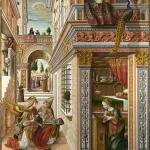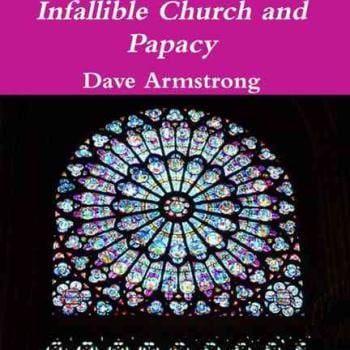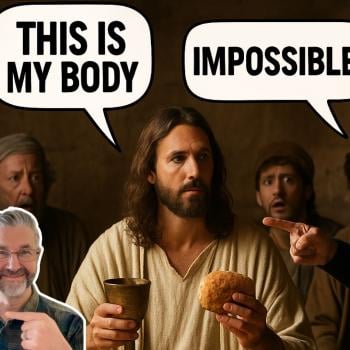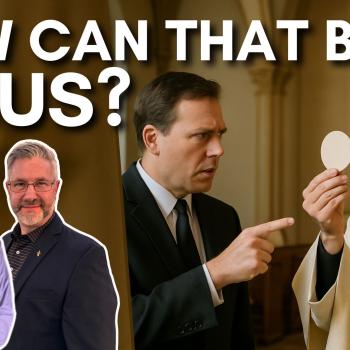. . . And Continued Cynical, Highly Selective, “Pick and Choose” Acceptance of the Teaching of Pope Benedict XVI
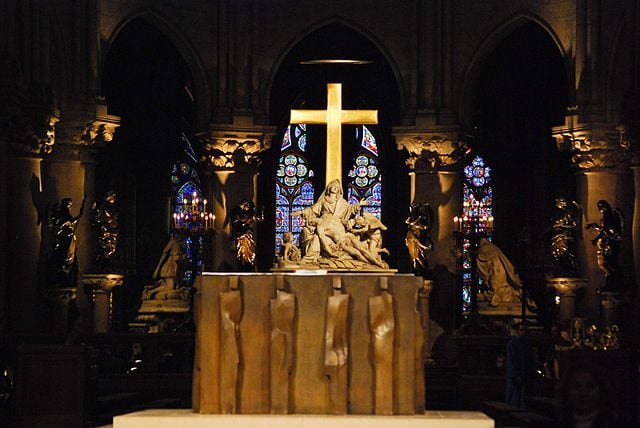
2 Timothy 4:3-4 (RSV) For the time is coming when people will not endure sound teaching, but having itching ears they will accumulate for themselves teachers to suit their own likings, [4] and will turn away from listening to the truth and wander into myths.
*****
Now there are memes circulating about the high altar at Notre Dame (for the Old / Tridentine / extraordinary form / Latin Mass) surviving the fire, while the [so-called] “Novus Ordo / Vatican II” altar did not. Therefore, it is supposedly a sign from God that we should get rid of the Pauline (“New”) Mass. [Note: there are, however, photographs (one / two) showing that the newer altar actually did survive]
The Church says that both forms of the Mass are equally valid (it was traditionalist darling Pope Benedict XVI — Apostolic Letter Summorum Pontificum in 2007 — who made this crystal clear).
The high altar was closer to the wall so the debris from the roof didn’t fall on it. The newer table altar was away from the back wall and made out of wood. That’s no “sign” at all. It’s the laws of physics. It would be like saying that the pews were destroyed, so it is a sign from God that we ought to remove all pews; or that the roof burned; therefore, churches ought not have a roof; or that the spire went down, and it was rebuilt in the 19th century; therefore spires (and renovations of churches) should be rejected. [but as I noted above, even this analysis presupposed that it was destroyed, and it seems not to have been]
Anyone who has followed and agreed with my writings for 22 years now of having a blog couldn’t possibly hold this absurd and superstitious and radical Catholic reactionary view. I’ve written about this issue of the forms of the Mass many times:
Michael Voris vs. the New (OF) Mass & Pope Benedict XVI [11-16-12]
Books by Dave Armstrong: Mass Movements: Radical Catholic Reactionaries, the New Mass, and Ecumenism [12-20-12]
Peter Kwasniewski, Fr. Thomas Kocik and a Growing Chorus Disagree with Pope Benedict XVI Regarding the Ordinary Form of the Roman Rite Mass (Or, Reports of the Death of the Reform of the Reform are Greatly Exaggerated) [+ Part Two] [2-26-14]
Who’s Defending Pope Benedict’s Summorum Pontificum Now? [2-26-14]
You Prefer the Tridentine / EF Mass? Great! You Prefer Novus Ordo / OF (like me)? Great! [8-14-15]
Two Forms of One Rite (Pope Benedict XVI) [11-4-15]
Critique of Criticisms of the New Mass [11-5-15]
Worshiping the TLM vs. Worshiping God Through It [12-16-15]
Traditionalist Misuse of Ratzinger “Banal” Quote [12-17-15]
Chris Ferrara vs. Pope Benedict XVI (New Mass) [12-18-15]
The irony is that legitimate traditionalists (with whom I am very close in spirit and practice) and reactionaries love Pope Benedict (or so they say, anyway). But when it comes to the Mass they will reject his magisterial teaching in a heartbeat, while I continue to defend him and his teaching, as I always have.
It’s like Jesus saying, “you say ‘Lord, Lord, but you don’t do what I say.” People cry, “Benedict, Benedict” and then turn around and thumb their noses at Summorum Pontificum and think like liberal Catholics and Protestants (i.e., rejection of papal authority).
Or they will ignore or reject, for example, his teaching (pre-pope, but still his opinion and not changed, as far as I know) that Vatican II and Trent carry precisely the same level of authority, so that if one rejects the authority of Vatican II, so they must also reject Trent by the same token:
It must be stated that Vatican II is upheld by the same authority as Vatican I and the Council of Trent, namely, the Pope and the College of Bishops in communion with him, and that also with regard to its contents, Vatican II is in the strictest continuity with both previous councils and incorporates their texts word for word in decisive points . . .
Whoever accepts Vatican II, as it has clearly expressed and understood itself, at the same time accepts the whole binding tradition of the Catholic Church, particularly also the two previous councils . . . It is likewise impossible to decide in favor of Trent and Vatican I but against Vatican II. Whoever denies Vatican II denies the authority that upholds the other two councils and thereby detaches them from their foundation. And this applies to the so-called ‘traditionalism,’ also in its extreme forms. Every partisan choice destroys the whole (the very history of the Church) which can exist only as an indivisible unity.
To defend the true tradition of the Church today means to defend the Council. It is our fault if we have at times provided a pretext (to the ‘right’ and ‘left’ alike) to view Vatican II as a ‘break’ and an abandonment of the tradition. There is, instead, a continuity that allows neither a return to the past nor a flight forward, neither anachronistic longings nor unjustified impatience. We must remain faithful to the today of the Church, not the yesterday or tomorrow. And this today of the Church is the documents of Vatican II, without reservations that amputate them and without arbitrariness that distorts them . . .
I see no future for a position that, out of principle, stubbornly renounces Vatican II. In fact in itself it is an illogical position. The point of departure for this tendency is, in fact, the strictest fidelity to the teaching particularly of Pius IX and Pius X and, still more fundamentally, of Vatican I and its definition of papal primacy. But why only popes up to Pius XII and not beyond? Is perhaps obedience to the Holy See divisible according to years or according to the nearness of a teaching to one’s own already-established convictions? (The Ratzinger Report, San Francisco: Ignatius, 1985, 28-29, 31)
Moreover, reactionaries and even some genuine traditionalists have frowned upon or heavily criticized Pope Emeritus Benedict’s resignation. Reactionary Michael Voris in 2015 went so far as to (abominably) contend that the Pope Emeritus essentially faked the extent of his illness and thus that his resignation was “immoral.”
Are we to follow the guidance of Holy Mother Church or not? I shall do so, and I hope and pray that my Catholic readers will not fall into this dangerous and contentious error of rejecting what the Church has authoritatively taught about the Mass.
***
Szász Péter wrote on my Facebook page: “The rubrics of the New Mass never and nowhere ordered to build in old churches new altars and destroy the communion rail or here, in the Notre Dame, the choir rail.”
I agree, and also agree that this new altar in Notre Dame is ugly and aesthetically unworthy and absurd (an opinion anyone may properly and freely express), but that’s a different issue. These people are saying, “get rid of the new Mass“; not just “get rid of the new [oftentimes ugly] table altars.” And they are using a ridiculous superstitious pseudo-“argument” to do so.
As for my own liturgical preferences: I just attended on Palm Sunday a Mass at my parish where the ordinary form Mass was celebrated ad orientem by the beautiful original altar from the late 1800s (here’s a picture of it), and where I received Holy Communion kneeling at an altar rail, on the tongue (as I have usually done since my conversion in 1990). I’m all for all that. I attended, for 25 years, one of the very few parishes in the Archdiocese of Detroit that offered the Tridentine Mass (before 2007). I love liturgical and architectural tradition.
What I am opposing presently is a “liturgical legalism (or pharisaism)” that would ignore what the Church teaches about the Mass, and (Luther-like) outrageously place personal preference on a higher level than the magisterium.
***
Photo credit: Eric Chan (9-2-07): modern table altar at Notre Dame, with the original high altar behind it [Wikimedia Commons / Creative Commons Attribution 2.0 Generic license]
***


